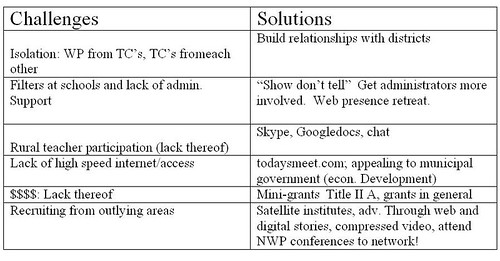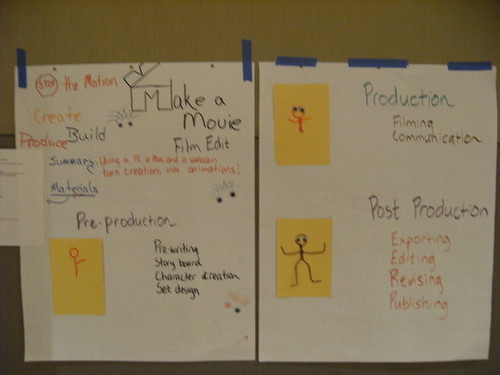 Sometimes at a conference, some of the most interesting conversations happen in the spaces in-between the official sessions. I made a few mental notes about some of the informal discussions that I was part of at the National Writing Project Annual Meeting last week — in hallways, near the snack area, after sessions, etc. — and thought I might share some of those topics out because I seem to think that they are bigger topics than I first imagined. That’s what happens when you get to talk with very smart people, as I was lucky enough to do last week.
Sometimes at a conference, some of the most interesting conversations happen in the spaces in-between the official sessions. I made a few mental notes about some of the informal discussions that I was part of at the National Writing Project Annual Meeting last week — in hallways, near the snack area, after sessions, etc. — and thought I might share some of those topics out because I seem to think that they are bigger topics than I first imagined. That’s what happens when you get to talk with very smart people, as I was lucky enough to do last week.
Digital Identities: A few of us had a long conversation one night about the use of social media and tools and how we go about finding a “voice” on those platforms that is real. We find ourselves often caught between our official role as a “teacher” and 0ur role as a creator of content. There are legitimate fears from educators about how authentic one’s online voice should be, and yet, I would argue that we need to let some of that come through in our writing, our sharing, our collaborations. Hiding behind a veil of parsed language seems increasingly at odds with why one would create an online space in the first place, doesn’t it? And yet, I myself create a sort of wall for myself, too, ducking behind a nickname in some spaces. But I do try to write with an authentic voice as much as possible.
Future of Apps: There is no doubt that the biggest change from last year’s NWP meeting to this year is the explosion of Apps on handheld devices, and there was plenty of talk outside of sessions about what that means. Will the use of Apps mean a push towards allowing cell phones and other handheld devices into the classroom? That’s what we wonder, and then, we talked about what that would mean. Will the influx of new applications open up new spaces and new ways for composing and creating? In a session I did around stopmotion movies, one of the participants pulled out his iPhone and used a new app (imotion) for making stopmotion that used the camera in his phone. In minutes, he had created a movie and emailed a version of it to me from his cell phone. That’s pretty amazing.
First Steps: I had a lot of conversations with folks, wondering how they could take their first steps into the digital conversations. I mentioned places to enter with Twitter, and with social networks, and I pushed the use of RSS feeders to follow blogs. It seems to be me that this wave of conversation signals a concern that teachers are being left behind, and that they cannot ignore the technology any longer, if that was their tact. There’s more and more talk, and more and more evidence, that the media and tools that our students are using outside of the classroom are not filtering their way in, and the teachers I talked with are concerned about that trend. They want to feel relevant to the lives of their students.
The Standards: This topic came up in sessions as well as out of sessions. How do we balance the use of technology with the push and pressures of standardized curriculum and assessment? It’s a legitimate concern, and one that is local to the school and district where we teach. Some of us have greater freedom, as long as we are following curriculum frameworks, while others have more shackles, such as a cookie-cutter curriculum. It seems to me that we need to find ways to get more administrators involved in the kind of discovery that teachers are doing. If teachers have that support from the principal or superintendent, they are more likely to dip their toes into the water.
Plugged Out: At our conference, there was no Internet access. The cost was too much for NWP, I suspect. What that meant was that all sessions were off-line explorations, which works better for some ideas than others. But it was clear that many of us felt odd and strange, off the grid as we were. Many of us (not all) are used to taking notes online, sharing ideas from conferences “in the moment,” using backchannels for related discussions, creating multimedia interpretations of events, etc. It wasn’t until someone in a session pointed out that what we were feeling in this unwired space was probably exactly what our students feel like when we tell them to turn off and hide their cell phones when they walk in the schools. It feels disjointed when you have integrated something into your ways of communicating, and then find it suddenly revoked. We persevered, as most of our students do, but it never felt quite right.
Access: This is a constant from year to year — how to make sure our student have access to the technology and access beyond the firewalls so that the tools that we want to use for learning are not hurdles of frustration. I still hear about computer labs being used only for reading assessments, and of firewall filters being so strict as to be meaningless. Like many, I long for the day when this is NOT an issue facing schools.
Peace (in the discussions),
Kevin


